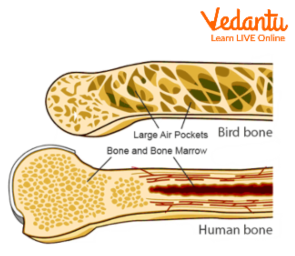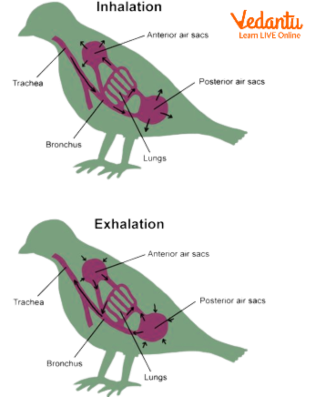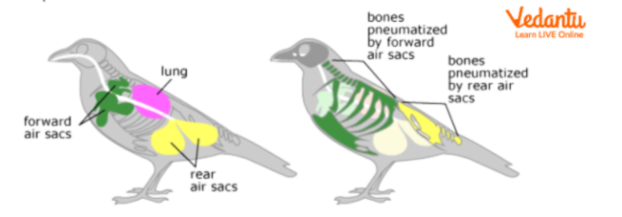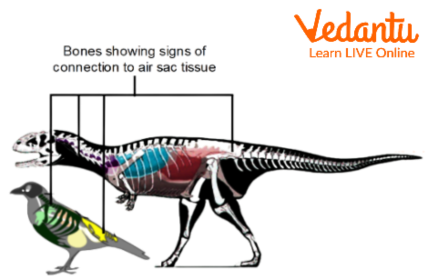Why Do Birds Have Hollow Bones? Understanding the Evolutionary Advantage
Pneumatized bones are hollow bones because they are filled with air space. It is believed that this shape facilitates oxygen intake during flight. The term pneumatic originated in the 17th century in France and pneumatique, but it dates further back to ancient Greece where pneuma means "wind" and pnein means "breathe." In contrast to car brakes, which are "closed," the mechanism in birds is "open" permitting air to pass through. The hollow portions of a bird's bones are connected by air sacs. Essentially, their lungs penetrate all of their bones. This aids the inhalation and exhalation of oxygen by birds. This increases the blood's oxygen content, giving a bird more energy for flight.
How are Human Bones Different from Hollow Bones Present in Birds?
A human bone is strong and dense and contains bone marrow. A bird bone, on the other hand, is hollow and inflated. Additionally, the bone possesses certain cross-sections, known as struts, that strengthen the bone and assist birds in withstanding taking off, flying, and landing. Although it would seem that hollow bones would make a bird's skeleton lighter than a mammal's, studies have revealed that a bird's skeleton weighs roughly the same as a mammal's. The hollow, dense bone, however, is stiffer and stronger than a mammal's, allowing it to withstand the strain and rigours of flight.

A Hollow Bone of a Bird vs a Human Bone
How do Birds Respire?
Both in terms of structure and ability to exchange gas as effectively as feasible, the avian respiratory system differs noticeably from the human respiratory system. The avian respiratory system is made up of a pair of lungs with static surfaces for gas exchange and coupled air sacs that expand and contract to circulate air through the static lungs. Before being completely used up and expelled out of the body, an inhaled breath of oxygen-rich air undergoes two full cycles of inhalation and exhalation in the respiratory system.
Description of the Avian Respiratory Cycle
It is composed of two respiratory cycles—each of which has four steps—that are completed as air is inhaled. The primary bronchi, which connect to the posterior air sacs, are where most of the air inhaled in step 1 travels. The air inhaled from the posterior air sacs enters the lungs in step 2, which is the exhale phase of this initial breath. As inhaled air travels through the air-capillary system, oxygen and carbon dioxide are exchanged. The oxygen-depleted air leaves the lungs and enters the anterior air sacs during step 3 of the bird's subsequent inhalation. The second and last exhale (step 4) returns air that is rich in carbon dioxide to the atmosphere from the bronchi, trachea, and anterior air sacs.

Inhalation and Exhalation in a Bird
Fresh air flows unidirectionally (one way) over the surfaces of the gas exchange system of the lungs. In addition, new air constantly flows over the gas exchange surfaces during inhalation and exhalation, providing the bird with a near-constant condition of gas exchange inside the lungs.
How do Hollow Bones Fit into All of this Then?
Pneumatic bones/hollow bones are connected to the air sacs in birds. A bird's anterior bones are linked to its anterior air sacs, as seen in the diagram below, while its posterior bones are linked to its posterior air sacs.

Hollow Bones and Air Sacs
Air sacs linked to the bones give the skeleton air pressure and strength, cool the bird by dispersing heated air and keep the bird light for flight.
Do All Birds Have Hollow Bones?
Although the proportion of hollow bones varies between species, not all of a bird's bones are hollow. Compared to diving birds, large gliding and soaring birds typically have more. There are no hollow bones in the bones of birds like penguins, loons, and puffins. These birds are said to dive more easily because of their sturdy bones. The bones of birds that cannot fly are hollow. The femurs of emus and ostriches are hollow. It is believed that they pant to cool themselves off by using the air sac system that extends into their upper legs. In the bones of carnivorous dinosaurs, fossils provide evidence of air pockets. The positions of the air sacs and bones in the early birds and dinosaurs are comparable.

Similarities Between Dinosaurs and Birds
The resemblance has helped to confirm that birds evolved from dinosaurs. Not only do birds have pneumatic or hollow bones, but so do you. Like bird skulls, human facial bones are pneumatic. In essence, pneumatic bones are your sinuses and can be located under your eyes, around the nose, and around your lower cheekbones.
Important Questions
1. What are hollow bones?
Ans: Hollow bones are also known as pneumatic bones which contain many air sacs and are thus hollow. It helps in the flight of the bird.
2. What are the differences between a mammal bone and a hollow bone?
Ans: Mammals have solid, denser bones filled with bone marrow while hollow bones are light and less dense filled with air sacs and help the birds to fly.
Practice Questions
1. What is the other name for hollow bones found in birds?
Pulverised bones
Solid bones
Pneumatic bones
Pseudo Pneumatic bones
Ans: Option (c)
2. Which of the following birds do not have hollow bones?
Eagle
Penguin
Pigeon
Hornbill
Ans: Option (b)
Key Features
Birds have pneumatic/hollow bones which are connected to the air sacs which increases the blood's oxygen content and gives a bird more energy for flight.
The air sacs in the hollow bones of a bird also function as thermoregulators and help the bird remain light during flight.


FAQs on Hollow Bones: Structure, Function, and Importance in Biology
1. What exactly is a hollow bone?
A hollow bone, known scientifically as a pneumatic bone, is a bone that is not filled with marrow but is mostly hollow and filled with air spaces. These air sacs are connected to the respiratory system, making the skeleton remarkably light but still strong enough to withstand physical stress.
2. How do hollow bones help a bird to fly?
Hollow bones are a key adaptation for flight in two major ways:
- Reduces Body Weight: By being filled with air instead of dense marrow, they make the bird much lighter, making it easier to achieve lift-off and stay in the air.
- Supports Respiration: The air sacs within the bones are part of the bird's respiratory system, allowing for a continuous, one-way flow of oxygen. This provides the high energy needed for sustained flight.
3. If hollow bones are mostly empty, what makes them so strong?
Hollow bones are not completely empty. They have a clever internal structure with thin, crisscrossing reinforcements called struts or trabeculae. This design is similar to the steel trusses used in bridges or towers, providing maximum strength and rigidity with minimal material, which keeps the bones from breaking during flight or landing.
4. Why don't humans have hollow bones like birds?
Human bones are designed for supporting weight and enduring stress on the ground, not for flight. Our bones are filled with marrow, which is vital for producing red and white blood cells. While some bones in the human skull (like the sinuses) are pneumatic to lighten the head, our skeletal system is fundamentally built for strength and support on land.
5. Are birds the only animals with hollow bones?
No, while birds are the most famous example, hollow bones were also a characteristic of extinct flying reptiles called pterosaurs. This type of bone structure is a powerful example of convergent evolution, where different species independently develop similar traits to solve a common problem, in this case, the challenge of flight.
6. Could a person fly if they somehow had hollow bones?
Even with a full skeleton of hollow bones, a person could not fly. Flight requires a combination of features that humans lack, such as wings with feathers for aerodynamics, massive chest muscles to power the wings, and an incredibly efficient respiratory and metabolic system to provide the necessary energy. Hollow bones are just one piece of the puzzle.










